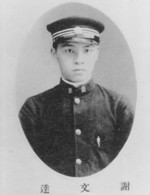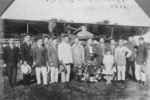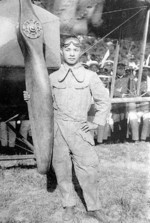Tsia Bun-tat
| Surname | Tsia |
| Given Name | Bun-tat |
| Born | 4 Mar 1901 |
| Died | 6 Jan 1983 |
| Country | Taiwan, China |
| Category | Military-Air |
| Gender | Male |
Contributor: C. Peter Chen
ww2dbaseTsia Bun-tat (Taiwanese with Tailo romanization: Tsia Bun-tat. Mandarin with Pinyin romanization: Xie Wenda) was born into a Hakka family in Taichu (now Taichung), Japanese-occupied Taiwan in Mar 1901. In Jun 1917, he saw a performance in Taichu by American stunt pilot Art Smith, and was inspired to become an aviator. His family ran a candy shop, and early successes allowed him to have the funding to travel to Japan after his 1919 graduation from Taichu Senior High School (now Municipal Taichung First Senior High School) to study at the Itoh Flying School in Chiba Prefecture. At the urging of activist friends, he took political courses at a local school in the evenings. Upon receiving his flight certification, he became the first Taiwanese pilot. In 1920, with an Itoh Emi 5 aircraft, he became the first Taiwanese touring flight show pilot as he performed in Taichu and Taihoku (now Taipei). He was one of the model citizens used by the Japanese colonial administration to demonstrate its success. In early 1923, Taiwanese activists petitioned the Japanese Diet to grant Taiwan the permission to establish a parliament, and thus receiving the right to self-rule. During this effort, Tsia flew over Tokyo, Japan spreading leaflets in support of the petition. Because some of the 100,000 leaflets he had dropped contained wording describing the Japanese government as tyrannical and authoritarian should the Diet reject the petition, Tsia, as the pilot who distributed them, he was threatened by Japanese government agents. Realizing that he had long been the subject of government monitoring due to his association with activists, he and his father traveled from Japan to China to escape persecution; meanwhile, the rest of his family in Taiwan also traveled to China as the family candy business had since gone poorly. They initially spent some time in Changchun in northeastern China, where distant relatives lived. Later, his family also established an automobile business in Tianjin in Sep 1923. Between late 1923 and Jun 1924, he worked in Tokyo as a reporter for the newly established Taiwan Minbao newspaper, returning to Changchun afterwards. In Jun 1925, he entered military service with the provincial forces of Henan Province at the rank of captain. In Oct 1925, he obtained Republic of China citizenship. In Mar 1926, he became an instructor at the government-run Guangzhou Aviation School in Guangdong Province, China. In 1927, he became an aviator with the National Revolutionary Army, and saw combat during the Northern Expedition. In 1928, he was assigned to the First Air Group of the Aviation Bureau of the Central Government's Ministry of Military Affairs, followed by becoming a staff officer with the Sixth Group, aviation instructor at the Whampoa Military Academy, and manager of the Xingzi Seaplane Airport in Jiangxi Province. In Jun 1930, during the conflict between the central government and the Guangxi warlords, Tsia was wounded by shrapnel from anti-aircraft fire. Being forced to crash land, he suffered a minor skull fracture during the landing. He received care in a field hospital in Hunan Province after the crash landing. In 1932, he served as a staff officer to air groups during the First Battle of Shanghai. As Japan continued to infringe on Chinese sovereignty, Tsia's superior officers began questioning his Taiwanese-Japanese background. Having heard rumors that a number of Taiwanese in the Chinese government and military had been rounded up and executed for being Japanese spies, he retired from the Chinese Air Force in Apr 1936 at the rank of major to escape the witch hunt.
ww2dbaseDuring the Second Battle of Shanghai in 1937, Tsia watched dogfights from the window of his home in Shanghai, wondering if any of the falling Chinese aircraft were occupied by his former students or former Chinese Air Force colleagues. During one evening in 1938, Japanese secret police visited him at his home and brought him in for questioning. A Japanese Navy captain forced him to take the position of the Deputy Secretary in the Shanghai city government, with the purpose of spying on the mayor for the Japanese occupation government. Tsia rejected initially, but eventually gave in to the captain's threats. After Shanghai, he also briefly worked as a secretary with Beiping Police under Japanese occupation authorities. In 1940, he served as one of Japanese puppet Wang Jingwei's translators. In 1941, he was made the deputy director of the Japanese-run China Air Transport's Shanghai branch office. He was later recruited by Wang to serve in the puppet regime's air ministry, but Tsia rejected the offer. He remained with China Air Transport until the company was disbanded with the war's end in 1945.
ww2dbaseIn 1946, Tsia returned to Taiwan and founded the Taiwan Iron Foundry in the Daqiaotou area of Taipei, which eventually went bankrupt. For many years, he kept his history to himself, fearing that his past associations with Japan would again bring harm to him or his family. Later, he worked with the Taiwan Provincial Parliament for 17 years as a special advisor of the industrial sector. He passed away at his home in Taipei in 1983, and his ashes were buried at the Tianxiang Temple in Wanli District, New Taipei City, Taiwan.
ww2dbaseSource: Wikipedia
Last Major Revision: Apr 2022
Tsia Bun-tat Interactive Map
Photographs
 |  |  |
Tsia Bun-tat Timeline
| 4 Mar 1901 | Tsia Bun-tat was born in the Oo-gu-lam area of Taichu Cho (now Taichung City), Japanese-occupied Taiwan. |
| 17 Oct 1920 | Tsia Bun-tat became the first Taiwanese touring flight show pilot as he performed in an Itoh Emi 5 aircraft in Taichu, Taiwan. |
| 30 Oct 1920 | Tsia Bun-tat performed a flight show in an Itoh Emi 5 aircraft over at the Taihoku Cavalry Training Field (now Machangding Memorial Park) in Taihoku (now Taipei), Taiwan. |
| 31 Oct 1920 | Tsia Bun-tat performed a flight show in an Itoh Emi 5 aircraft over at the Taihoku Cavalry Training Field (now Machangding Memorial Park) in Taihoku (now Taipei), Taiwan. |
| 12 Apr 1923 | Tsia Bun-tat arrived in China. |
| 21 Oct 1925 | Tsia Bun-tat obtained Republic of China citizenship. |
| 30 Apr 1936 | Tsia Bun-tat retired from the Chinese Air Force at the rank of major. |
| 6 Jan 1983 | Tsia Bun-tat passed away in his home on Jinling Street, Taipei, Taiwan, Republic of China. |
Did you enjoy this article or find this article helpful? If so, please consider supporting us on Patreon. Even $1 per month will go a long way! Thank you. Share this article with your friends: Stay updated with WW2DB: |
» First Battle of Shanghai
- » 1,150 biographies
- » 337 events
- » 43,917 timeline entries
- » 1,241 ships
- » 350 aircraft models
- » 207 vehicle models
- » 375 weapon models
- » 123 historical documents
- » 260 facilities
- » 470 book reviews
- » 28,545 photos
- » 432 maps
James Forrestal, Secretary of the Navy, 23 Feb 1945
Please consider supporting us on Patreon. Even $1 a month will go a long way. Thank you!
Or, please support us by purchasing some WW2DB merchandise at TeeSpring, Thank you!